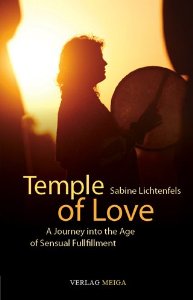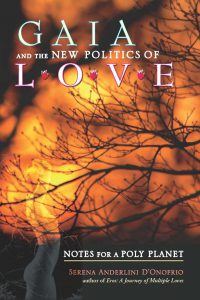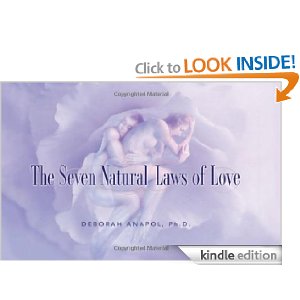Dear Earthlings:
The EcoSex course at U Conn is in process. It’s a great experience. We are expanding horizons with clustered reading: Theory of Science, Cultural Theory, Ecological Theory. We each read related books, then report to group. More thinking out of the box and across disciplines. Students are sending their book reports in. In class, we connect the dots. From a holograph of what we’ve read together, the “required readings.” What’s the connection with our clustered themes? Multiple perspectives and good synergy. Here, we offer a glimpse. Sabine Lichtenfels‘s Temple of Love is one of five “Cultural Theory” books. We got Alex to report on it.
Alexandra Mayer:
A Book Report on Temple of Love: A Journey into the Age of Sensual Fulfillment
by Sabine Lichtenfels
 Temple of Love seems to be a handbook for EcoSexuality. The author, Sabine Lichtenfels, favors free love, arguing that free love exists for the “reconnection and re-entry to greater contexts of information and communication”(55). In this she means that free love is universal love. A person should not hoard their love, but should let it flow naturally. This in turn will link the loving individual with all of nature and Mother Earth herself. She claims that personal love is selfish, and makes a good point that it often stems from the yearning for possession. Often, males want to own females, and control them. This spurs jealousy, feelings of inadequacy, and despair. She furthers her promotion of free love by stating, “The wish of a woman to belong fully to a man is a slightly lower and less connected version of the wish to fully love and recognize a person”(241). Thus, connection with the earth and all her belongings creates a true love of others.
Temple of Love seems to be a handbook for EcoSexuality. The author, Sabine Lichtenfels, favors free love, arguing that free love exists for the “reconnection and re-entry to greater contexts of information and communication”(55). In this she means that free love is universal love. A person should not hoard their love, but should let it flow naturally. This in turn will link the loving individual with all of nature and Mother Earth herself. She claims that personal love is selfish, and makes a good point that it often stems from the yearning for possession. Often, males want to own females, and control them. This spurs jealousy, feelings of inadequacy, and despair. She furthers her promotion of free love by stating, “The wish of a woman to belong fully to a man is a slightly lower and less connected version of the wish to fully love and recognize a person”(241). Thus, connection with the earth and all her belongings creates a true love of others.
This really resonated with me. I recently broke up with my boyfriend without really knowing why. I knew that I loved him and I knew that he loved me. Still, something was wrong. He was generally kind and caring, but would sometimes erupt with feelings of anger and inadequacy. These bouts of emotion had extremely intense effects on my well being. I would find myself drowning in the dark vibes, feeling all that he felt, heartbroken long after each individual event had ended. I fell into paranoia, thinking he was always mad at me. I realize now, that this behavior stemmed from his attempt to own me. He loved me the wrong way. His passion urged him to keep me to himself. When his subconscious forced him to understand that as a human and a free spirit, I was impossible to own, rage would well within him. He would then try to hide these feelings, knowing that he should love me for me or fully “recognize” me instead of trying to change certain aspects so that I would be eternally his. The suppressed emotions would then lead to episodes. Like Manu and Meret in Temple of Love we were not ready for personal love. (I do, however, differ from the author’s belief that monogamy never works).
Sabine Lichtenfels talks a great deal about Manu and Maret. She claims that their love, the first of personal love, led to the patriarchal society in which we live today. Manu’s longing to own Maret and her submission created of feelings of power in Manu, for he realized that he could act free of Mother Earth. This hunger for independent power eventually manifested in a murder committed by Manu. This only intensified his craving for individual action. Manu, thus, severed the human tie with nature by realizing individuality.
Humans no longer act to benefit a system of a whole. This, in turn, spurs violence, hatred, and dismay. Harmful climate change for instance, is a result of individuality. People, looking for profit, caring not for others’ well beings, continue to mine, to waste energy, and to damage earth. In the short run convenience and revenue are increased. These benefits, of course, will not last. The melting caps and impending disaster will swallow up the benefits along with the human race. Every act the individual takes at the expense of the whole will haunt him eventually, for the individual is part of the whole.
Sabine Lichtenfels elaborates on the link between the individual and the whole by stating, “private therapy alone cannot bring healing… because there is no private disease”(235). This statement showcases the detrimental effects a society can have. Private disease does not exist because problems often stem from the environment in which one lives and the social mores that control said environment. A book that showcases this idea is the Feminine Mystique. For this masterpiece, Betty Friedan interviewed a variety of middle class suburban women. Most of the women felt they should be happy, but couldn’t rid themselves of a certain despondence. Many ignored their despair, feeling that their pain displayed a personal flaw. Betty Friedan found, however, that the pain of a woman enslaved in domestic duty was universal. Feminine Mystique put a name to the societal problem that plagued various individuals. The realization that the womanly pain due unequal rights was cultural and not personal spurred a movement. It is interesting to contemplate how far Sabine Lichtenfels statement can go. Are certain mental problems results of our culture? In America the sociopathic rate is one in twenty. In Japan the rate is one in one-hundred. With epigenetics, the scientific idea that certain genes are only expressed if triggered by a certain event, the idea that private problems do not exist is validated.
I was especially intrigued with Sabine Lichtenfels take on religion. She argues that the male god of christianity is angry and misogynistic. At first I was taken aback by her description, but then I realized she was criticizing certain aspects of the christian institution and not what she believed to be a “real” higher power. I realized while reading this book that a priest can call God “rock, water, whine, bread, tree,” but can never call God “woman.” To me this fact is greatly distressing. Furthermore, alters are reserved for men, which furthers Sabine Lichtenfels claim that christianity is anti-woman and thus an anti-natural institution.
Furthermore, her glorification of the snake symbol, which has always represented the freedom of women and sensuality, displayed a rare self love. It was extremely refreshing and new to see the snake/serpent showcased in a positive light. Even those that are not religious see depictions of the snake as evil in various pieces of literature. The fact that I have never seen the snake as a positive symbol, proves that our society has an ingrained bias against the freedom and sexuality of women. In this, society opposes nature.
Temple of Love is filled with wise insights. One such insight is as follows: “When I am fully in the present, I am protected from fear”(245). Fear, of course, is negative. It sucks from us the will to do whatever it is that we really dream of, leaving us empty. We often hear the question “What would you attempt if you knew you could not fail?” Sadly, this question reminds many people that they are not fulfilling their wishes, for the answer, the representation of what one wants, is usual at in dissonance with reality, what one does. Many recognize that fear is detrimental, but neither dissect its hold on them nor attempt to cure the disease. By stating “When I am fully in the present, I am protected from fear,” Sabine Lichtenfels addresses the cause and anecdote.
This statement shows that fear comes from pondering the past or the future with too much depth. It makes sense. It’s something I should have thought of before. While it is good to learn from mistakes of yesterday, it is harmful to wallow in regret. For example, those who have been betrayed by a loved one, often close their souls to avoid yet another painful encounter. For such individuals, fear of love stems from past heartaches. For others, the future spurs destruction. Of course, one must plan for future goals. And sure, a great deal of hope rests in the future. However, if one thinks only of tomorrow, fear will control them. People rely too heavily on prolonged gratification. In that I mean people ignore present euphorias for a secure future. Fear forces people to do this. A common thought process is “if I don’t work work work, and ignore all that is around me, I will not achieve X.” The solution? Live presently. It’s cheesy. It’s cliche. It’s true. Soak in the beauty within every moment, adore each second of each day, realize the miracles of life that surround you, and fear will disappear. The dearth of fear, in turn, will create a happier and healthier life.
Other advice in Temple of Loveincludes, “This is why they say ‘Love is blind.’ You look outside for what you have forgotten or betrayed inside yourself”(243). In my copy of the book, I put stars and hearts next to this statement. If we expect others to encompass all that we are not, all that we wish we were, we will constantly be let down. This is an unfair weight to put on another. Still, most of us fall into this trap. “He/she balances me out” we say. This attitude transforms love into dependence. If and individual needs someone to “complete” him, he is obviously short of something necessary to his well being. Furthermore, this type of relationship ignores the lover’s actual personality. The incomplete individual does not see his love for what they are, rather for what he himself is not. This is not true love.
Something very powerful in this book is the idea of justified and controlled anger, or “sacred anger.” In a spiritual trance, during which the author feels another’s being, Sabine Lichtenfels hears the words, “I will become the witness of the thoughts which arise from anger, and I have the task of transforming them into a sacred and peaceful power”(120). From this passage, I realized that anger often has a valid source. There are certain evils that need transformation. The resulting anger, however, is detrimental and useless. If we can separate anger from its source, we can identify specific injustices and work with a clear mind to halt the wrongs.
There were many amazing ideas and thoughts in this book. I have not yet touched upon so much that touched me. I do, however, want to share the part of the book that did not please me. Sabine Lichtenfels often talks of male and female as “polar opposites” and creates her own very rigid gender standards. I personally subscribe to the belief that gender is a social construct. I believe that soul, and not body determines an individual’s disposition and that were we free of social mores our genders would be more fluid. Sex, the biological determinant of male and female, too could be argued to be a social construct. One in seven people are born with such biology that calls for surgery in order to make an individual fall under the category “boy” or the category “girl.” With this fact, I surrender all belief in the “male/female” system. Her book was, however, most uplifting for those who identify as “women” and follow the societal ideals of today. She also painted an absolutely stunning picture of natural femininity, that, while I don’t necessarily agree with, I respect and admire.
Sabine Lichtenfels is a wise and intensely creative woman. Her visions of the past, though not historically validated, are beautiful and meaningful. She tells a story, true or not, that lends itself to teaching. As a growing youth, still forming ideas about the world around me and piecing together what I believe to be true, I find that Temple of Love might just have a lasting impact on my ideology. It has brought many previously unexplored ideas to me, which I am eager to think on.
Alexandra Mayer
Published with permission
WGSS 3998 – Ecosexuality and the Ecology of Love
Prof. Serena Anderlini-D’Onofrio
U Conn, Storrs, Spring 2013
Dear Earthlings:
Let “nature” be your teacher in the arts of love. Education is the heart of democracy, education to love. Come back for more wonders: Book Reports to appear every other Thursday. Book Reports scheduled every other Thursday. Check out our summer offerings: Ecosexuality in Portland, OR, July 17-21. Registration here!
Namaste,
Serena Anderlini-D’Onofrio, PhD
Gilf Gaia Extraordinaire
Author of Gaia, Eros, and many other books about love
Professor of Humanities
University of Puerto Rico, Mayaguez
Follow us in the social media
Author’s Page/Lists all books:





http://polyplanet.blogspot.com

















